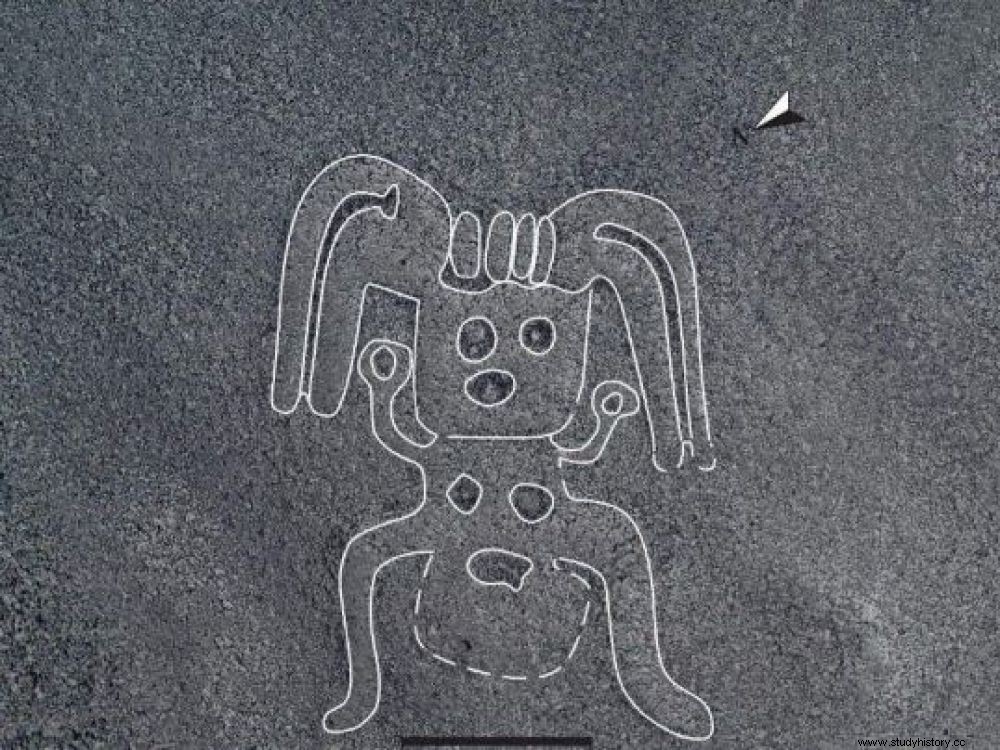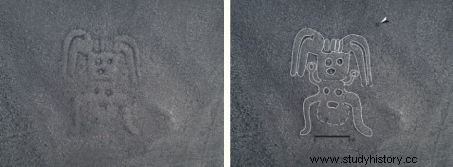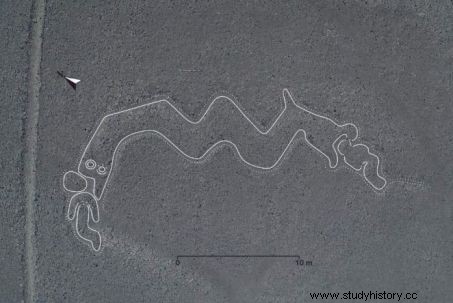Japanese archaeologists have discovered unknown geoglyphs with human and animal shapes in the Nazca Plain, south of Lima, Peru.

With his feather headdress, this character with anthropoid features is one of the hundred new geoglyphs discovered in the Nazca region.
Japanese scientists from Yamagata University have identified the presence of 143 new giant figures called geoglyphs, in the arid pampas of Nazca and Jumana, 400 km south of Lima, Peru. It is with the collaboration of the IBM Japan research center and the use of artificial intelligence (AI) technologies that Masako Sakai, who has been leading this exploration mission since 2004, revealed these works. Hardly visible to the naked eye because of their gigantism, and above all the erosion that erases them over the years, these monumental patterns were identified from high-resolution images and 3D laser scanner recordings made in 2018.
Representations of human beings, plants and animals such as snakes, fish, birds and llamas have thus been distinguished. Very satisfied with the results, the researchers plan above all "to continue to use artificial intelligence to search for new figures", according to the press release issued by the Japanese University.

Comparison between the image detected in the plain of Nazca, and the features identified by the AI. © Yamagata University / IBM Japan
Recently, in 2018, Sciences et Avenir had devoted an article to the discovery of some thirty other figures north of Nazca by Peruvian teams, including one conducted in the Palpa Valley, by Aïcha Bachir-Bacha, Andean archaeologist at the École des Hautes Études en Social Sciences (EHESS), in Paris (read Sciences et Avenir n°861 ). These works were produced by the Nazca civilization which flourished at the foot of the Andes between the 3rd century BC and the 7th century AD. But also in some cases, by their predecessors, the Paracas, farmers having lived in this same region between 800 BC. J.C and 200 after J.-C. The originality of these populations is to have traced on the ground of the desert these strange assemblies which did not cease inflaming the spirits.

Processed image of a "two-headed serpent" and two human figures. ©Yamagata University / IBM Japan
Works from agricultural communities
Japanese scientists from Yamagata University have identified the presence of 143 new giant figures called geoglyphs, in the arid pampas of Nazca and Jumana, 400 km south of Lima, Peru. It is with the collaboration of the IBM Japan research center and the use of artificial intelligence (AI) technologies that Masako Sakai, who has been leading this exploration mission since 2004, revealed these works. Hardly visible to the naked eye because of their gigantism, and above all the erosion that erases them over the years, these monumental patterns were identified from high-resolution images and 3D laser scanner recordings made in 2018.
Representations of human beings, plants and animals such as snakes, fish, birds and llamas have thus been distinguished. Very satisfied with the results, the researchers plan above all "to continue to use artificial intelligence to search for new figures", according to the press release issued by the Japanese University.

Comparison between the image detected in the plain of Nazca, and the features identified by the AI. © Yamagata University / IBM Japan
Recently, in 2018, Sciences et Avenir had devoted an article to the discovery of some thirty other figures north of Nazca by Peruvian teams, including one conducted in the Palpa Valley, by Aïcha Bachir-Bacha, Andean archaeologist at the École des Hautes Études en Social Sciences (EHESS), in Paris (read Sciences et Avenir n°861 ). These works were produced by the Nazca civilization which flourished at the foot of the Andes between the 3 th century BC and the 7 th century AD. But also in some cases, by their predecessors, the Paracas, farmers who lived in this same region between 800 BC. J.C and 200 after J.-C. The originality of these populations is to have traced on the ground of the desert these strange assemblies which did not cease inflaming the spirits.

Processed image of a "two-headed serpent" and two human figures. ©Yamagata University / IBM Japan
Works from agricultural communities
Grandiose arabesques carried out successively by communities of farmers for 1500 years, hundreds of these effigies scarify the Peruvian desert. Executed on land that iron oxide colored gray, they were made by scraping the surface layers of the stony ground, to bring out the lighter gypsum levels located below. The Nazcas and the Paracas were inspired by the same motifs as those that decorated their pottery or the textiles that made them famous. Far from the fanciful hypotheses put forward in the middle of the 20 e century to explain these extraordinary decorations that could only be seen from the sky. The geoglyphs would be linked to agricultural calendars, a complex irrigation system, and places of ritual worship dedicated to different deities. They may also be territory markers.
These human achievements, listed on the UNESCO World Heritage List since 1994, remain very fragile due to the threat posed to them by the proximity of certain urban areas. Remember that the figures and "lines" of Nazca, Palpa, Ica or Chincha, the different valleys and plains in which they are found scattered over about fifty kilometers are not unique on the American continent, other geoglyphs also exist in the desert in northern Chile, as well as a few others in North America.
A century of prospecting
Mentioned from the 16
e
century by the Spanish chronicler Pedro Cieza de Leon (1250-1254), the alignments and figures of Nazca were mainly unveiled from 1927 by Peruvian aviators. Prospected from 1939 by the American anthropologist Paul Kosok, but it was with the work of Maria Reiche, a German mathematician who arrived in Peru in 1932, that these Cyclopean drawings became universally famous. Like Paul Kosok, she had seen in these geoglyphs instruments for measuring the movement of the stars. In 1926, a Peruvian anthropologist named Toribio Mejia Xesspe had seen in these alignments a system of sacred paths taken during ceremonies. Hypothesis today shared by the majority of specialists.
